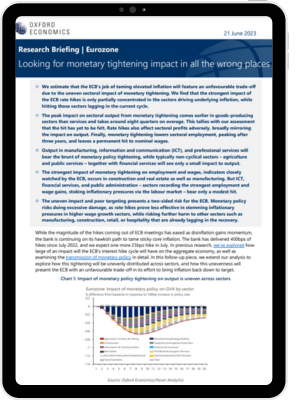Research Briefing
| Jun 21, 2023
Eurozone: Looking for monetary tightening impact in all the wrong places

We estimate that the ECB’s job of taming elevated inflation will feature an unfavourable trade-off due to the uneven sectoral impact of monetary tightening. We find that the strongest impact of the ECB rate hikes is only partially concentrated in the sectors driving underlying inflation, while hitting those sectors lagging in the current cycle.
What you will learn:
- Output in manufacturing, information and communication (ICT), and professional services will bear the brunt of monetary policy tightening, while typically non-cyclical sectors – agriculture and public services – together with financial services will see only a small impact to output.
- The strongest impact of monetary tightening on employment and wages, indicators closely watched by the ECB, occurs in construction and real estate as well as manufacturing. But ICT, financial services, and public administration – sectors recording the strongest and employment and wage gains, stoking inflationary pressures via the labour market – bear only a modest hit.
- The uneven impact and poor targeting presents a two-sided risk for the ECB. Monetary policy risks doing excessive damage, as rate hikes prove less effective in stemming inflationary pressures in higher wage growth sectors, while risking further harm to other sectors such as manufacturing, construction, retail, or hospitality that are already lagging in the recovery.
Tags:
Related Services

Service
European Cities and Regions Service
Regularly updated data and forecasts for 2,000 locations across Europe.
Find Out More
Service
European Macro Service
A complete service to help executives track, analyse and react to macro events and future trends for the European region.
Find Out More
